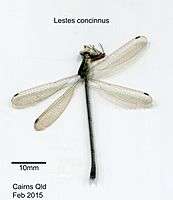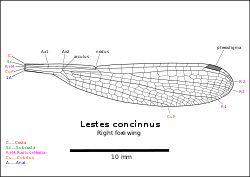Lestes concinnus
Lestes concinnus is a species of damselfly in the family Lestidae,[3] the spreadwings. They are so named because they rest with their wings spread. This species is known commonly as the dusky spreadwing.[4] It is a nomadic damselfly found in India, Southeast Asia as far as New Caledonia, and northern parts of Australia.[4]
| Dusky spreadwing | |
|---|---|
.jpg) | |
| Female, Thailand | |
.jpg) | |
| Male, Thailand | |
| Scientific classification | |
| Kingdom: | Animalia |
| Phylum: | Arthropoda |
| Class: | Insecta |
| Order: | Odonata |
| Suborder: | Zygoptera |
| Family: | Lestidae |
| Genus: | Lestes |
| Species: | L. concinnus |
| Binomial name | |
| Lestes concinnus | |
 | |
| Synonyms | |
|
Lestes paludosus | |
The adult is a medium-sized damselfly about 40 millimeters long with a wingspan around 45 millimeters. It is dusky-grey on dorsal surfaces graduating to light bluish-green on the sides and beneath. In Australia, the distribution is in suitable habitat in the north-west and north-eastern part of the continent from about Broome to the south-eastern Queensland border.[4]
This species can be found in freshwater habitat types such as river lagoons, ponds, and swamps. Its population size is unknown but it has a wide range. Threats to the species have not been assessed. It is listed as a least-concern species on the IUCN Red List.[1]
Gallery
 Female, Cairns, Queensland, Australia
Female, Cairns, Queensland, Australia.jpg) Female, Thailand
Female, Thailand Male showing blue abdomen
Male showing blue abdomen Head
Head Wing vein diagram right forewing
Wing vein diagram right forewing.jpg) Photo of female wings
Photo of female wings.jpg) Photo of male wings
Photo of male wings
References
| Wikimedia Commons has media related to Lestes concinnus. |
- Dow, R.A. (2017). "Lestes concinnus". IUCN Red List of Threatened Species. 2017: e.T158656A83379420. doi:10.2305/IUCN.UK.2017-1.RLTS.T158656A83379420.en.
- Selys-Longchamps, E. (1862). "Synopsis des Agrionines, seconde légion: Lestes". Bulletin de la Classe des Science, Académie Royale de Belgique. 2 (in French). 13: 288–338 [321].
- "Species Lestes concinnus Hagen, 1862". Australian Faunal Directory. Australian Biological Resources Study. 2012. Retrieved 10 April 2017.
- Theischinger, G; Hawking, J (2006). The Complete Field Guide to Dragonflies of Australia. Collingwood Vic.: CSIRO Publishing. p. 30. ISBN 978 0 64309 073 6.
